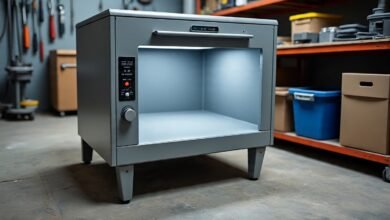Best Budget Laptops for Students Under $500 (2025 Edition)
Discover the best budget laptops for students under $500 in 2025 top-performing, durable picks for school with great battery life & specs.

Finding the perfect laptop as a student can be challenging, especially when working with a tight budget. The best budget laptops for students need to balance performance, portability, and affordability without compromising on essential features. In 2025, the market offers numerous excellent options under $500 that can handle everything from basic word processing to online learning and light multimedia tasks.
This comprehensive guide will help you discover the top affordable laptop options that deliver exceptional value for students pursuing their academic goals. Whether you’re taking notes in lectures, writing research papers, or participating in virtual classes, these budget-friendly devices will support your educational journey without breaking the bank.
Why Students Need Reliable Budget Laptops
Budget laptops for students have become essential tools in modern education. With the shift toward digital learning, online assignments, and virtual collaboration, having a dependable computer is no longer optional—it’s necessary. Students require devices that can handle multiple applications simultaneously, provide decent battery life for all-day use, and offer sufficient storage for academic materials.
The challenge lies in finding laptops that deliver adequate performance within a student’s financial constraints. Many students face budget limitations while needing devices capable of running productivity software, web browsers with multiple tabs, and video conferencing applications. Fortunately, 2025 has brought significant improvements in budget laptop performance, making it possible to find excellent options under $500.
Modern affordable laptops for college students offer features that were once exclusive to premium models. These include solid-state drives for faster boot times, improved processors for better multitasking, and enhanced display quality for comfortable extended use. The key is understanding which features matter most for academic success and identifying devices that prioritize these essential capabilities.
Essential Features to Consider in Student Laptops
When evaluating cheap laptops for students, several critical features determine whether a device will support your academic needs effectively. Understanding these specifications helps you make informed decisions and avoid costly mistakes.
Processor Performance
The processor serves as the brain of your laptop, directly impacting how smoothly applications run and how quickly tasks complete. For student use, modern budget processors from AMD and Intel provide sufficient power for typical academic activities. Look for processors like AMD Ryzen 3 or Intel Core i3, which offer excellent price-to-performance ratios.
These processors handle word processing, web browsing, email, and light multimedia tasks without significant slowdowns. While they may not excel at demanding applications like video editing or gaming, they provide reliable performance for standard academic workloads.
Memory and Storage Requirements
RAM affects your laptop’s ability to run multiple applications simultaneously, which is crucial for students who need to have browsers, document editors, and communication tools open concurrently. A minimum of 8GB RAM is recommended for comfortable multitasking, though some budget models start with 4GB.
Storage type significantly impacts overall system responsiveness. Solid-state drives (SSDs) provide faster boot times, quicker application launches, and improved overall system performance compared to traditional hard drives. Even a smaller SSD (256GB) typically offers better user experience than larger traditional storage options.
Display Quality and Size
Students spend considerable time looking at their laptop screens, making display quality important for eye comfort and productivity. A 13-15 inch screen provides good balance between portability and usability. Look for displays with at least 1920×1080 resolution for clear text and adequate workspace.
Screen brightness and viewing angles also matter, especially for students who work in various lighting conditions or collaborate with classmates. While budget laptops may not offer premium display features, decent color accuracy and contrast improve the overall experience.
Battery Life and Portability
Student laptops under $500 should provide sufficient battery life for a full day of classes without constant charging. Look for models offering 6-8 hours of typical use, which covers most academic schedules. Consider that battery life varies significantly based on usage patterns and power settings.
Weight and build quality affect daily portability. Students carrying laptops between classes benefit from lighter models with sturdy construction. While budget laptops may use more plastic components, well-designed models can still provide adequate durability for normal academic use.
Top Budget Laptop Recommendations for Students
Acer Aspire 5 Series
The Acer Aspire 5 consistently ranks among the best budget laptops for students due to its balanced feature set and competitive pricing. Available configurations under $500 typically include AMD Ryzen processors, 8GB RAM, and SSD storage options. The 15.6-inch display provides comfortable workspace for academic tasks.
This laptop excels in providing reliable performance for everyday student activities. The keyboard offers decent typing experience for extended writing sessions, while the trackpad responds accurately to gestures. Build quality, while not premium, proves adequate for typical student use patterns.
Battery life reaches 7-8 hours under normal usage, supporting full academic days without charging concerns. The variety of ports includes USB-A, USB-C, and HDMI connections, accommodating various peripherals and presentation needs.
Lenovo IdeaPad 3
Lenovo’s IdeaPad 3 series offers excellent value in the budget category, frequently appearing in affordable laptops for college students recommendations. Available with both AMD and Intel processors, these laptops provide solid performance for academic applications.
The 14-inch and 15.6-inch models offer different portability versus screen size trade-offs. The smaller variant appeals to students prioritizing mobility, while the larger version provides more comfortable workspace for extended use. Both feature adequate keyboards for typing assignments and taking notes.
Storage options include both traditional hard drives and SSD configurations, with the latter providing noticeably better performance. The IdeaPad 3’s thermal management keeps the system cool during normal use, preventing performance throttling during important tasks.
HP Pavilion 15
HP’s Pavilion 15 series delivers dependable performance in the budget segment, making it a strong contender for students seeking reliable computing power. Recent models feature improved processors and memory configurations that handle academic workloads effectively.
The laptop’s design emphasizes practicality over flashiness, with a focus on functionality that appeals to students. The keyboard provides comfortable typing experience, while the display offers adequate brightness for various lighting conditions. Build quality exceeds expectations for the price point.
Connectivity options include modern standards like USB-C alongside traditional ports, ensuring compatibility with both new and existing peripherals. The integrated webcam and microphone support video conferencing requirements for online classes and virtual collaboration.
ASUS VivoBook 15
ASUS positions the VivoBook 15 as an accessible option for students and budget-conscious users. The laptop typically features AMD Ryzen processors that provide excellent performance per dollar, making it competitive among cheap laptops for students.
The 15.6-inch display offers good viewing angles and color accuracy for the price range. The ErgoLift hinge design slightly elevates the keyboard for improved typing comfort during long study sessions. This attention to ergonomics demonstrates ASUS’s understanding of student usage patterns.
Storage configurations include SSD options that significantly improve system responsiveness compared to traditional hard drives. The laptop’s slim profile and reasonable weight make it suitable for daily transport between classes and study locations.
Performance Comparison and Benchmarks
Understanding how budget laptops for students perform in real-world scenarios helps inform purchasing decisions. While these devices won’t match premium models in raw performance, they can handle typical academic tasks effectively when properly configured.
Processor Performance Analysis
Modern budget processors from AMD and Intel provide surprising capability for their price points. AMD’s Ryzen 3 processors often outperform Intel’s Core i3 counterparts in multi-core tasks, making them excellent choices for students who multitask frequently. Single-core performance remains adequate for most applications students encounter.
These processors handle Microsoft Office applications, web browsing with multiple tabs, and video streaming without significant performance issues. While they may struggle with demanding applications like video editing or complex simulations, they excel at standard academic workloads.
Memory and Multitasking Capabilities
Eight gigabytes of RAM represents the sweet spot for student laptops, allowing comfortable multitasking between browsers, document editors, and communication applications. Systems with 4GB RAM often experience slowdowns when multiple applications run simultaneously, impacting productivity.
Virtual memory management becomes crucial on budget systems with limited RAM. SSDs significantly improve virtual memory performance compared to traditional hard drives, making them valuable upgrades even when total RAM capacity is limited.
Real-World Usage Scenarios
Student laptops under $500 excel in typical academic scenarios like writing papers, researching online, attending virtual classes, and creating presentations. These tasks rarely stress modern budget processors, allowing students to work efficiently without performance concerns.
Battery life during real-world usage varies significantly based on power settings and application demands. Web browsing and document editing consume less power than video streaming or video conferencing, affecting overall battery duration throughout academic days.
Budget-Friendly Alternatives and Refurbished Options
Students seeking affordable laptops for college students should consider refurbished business laptops, which often provide superior build quality and performance compared to new budget models. These devices, typically from corporate leases, offer excellent value when purchased from reputable sellers.
Refurbished Business Laptops
Former business laptops like ThinkPads or Dell Latitudes often feature better keyboards, displays, and build quality than new budget consumer models. These devices typically include professional-grade components designed for reliability and longevity.
The main considerations involve warranty coverage and battery condition. Reputable refurbishment programs address these concerns by replacing batteries and providing limited warranties. The savings often allow students to access higher-performance configurations within their budgets.
Chromebook Considerations
Chromebooks represent another category of cheap laptops for students, particularly those whose academic work centers around web-based applications and Google Workspace. These devices offer excellent battery life and quick boot times at very affordable prices.
However, Chromebooks have limitations regarding software compatibility and offline functionality. Students requiring specific Windows or Mac applications may find Chromebooks inadequate for their needs. The decision depends heavily on individual academic requirements and software preferences.
Optimizing Your Budget Laptop for Academic Success
Maximizing the performance of best budget laptops for students requires understanding how to configure and maintain these systems effectively. Proper optimization can significantly improve user experience and extend device lifespan.
Software Optimization Strategies
Removing unnecessary startup programs and bloatware improves boot times and system responsiveness. Many budget laptops include pre-installed software that consumes system resources without providing value to students. Careful removal of these programs can free up memory and processing power.
Keeping the operating system updated ensures access to performance improvements and security patches. Modern Windows and macOS versions include optimizations specifically designed to improve performance on lower-end hardware.
Storage Management
Maintaining adequate free space on storage drives prevents performance degradation and ensures smooth operation. Students should regularly clean temporary files, manage download folders, and use cloud storage for files that don’t require local access.
SSD optimization differs from traditional hard drive maintenance. Avoiding defragmentation and enabling TRIM commands helps maintain SSD performance over time. These optimizations are particularly important on budget systems where storage capacity may be limited.
Hardware Upgrades
Some budget laptops for students offer upgrade possibilities that can extend their useful life. RAM upgrades often provide the most significant performance improvements, particularly on systems initially configured with 4GB memory.
Storage upgrades from traditional hard drives to SSDs can dramatically improve system responsiveness. While not all budget laptops support these upgrades, those that do offer excellent opportunities for performance enhancement within reasonable budgets.
Conclusion and Final Recommendations
Selecting the best budget laptops for students requires balancing performance, features, and affordability while considering individual academic needs. The models highlighted in this guide represent excellent options under $500 that can support students throughout their educational journey.
The Acer Aspire 5 emerges as a top choice for students seeking reliable performance and good value. Its combination of modern processors, adequate memory, and solid build quality makes it suitable for most academic applications. The Lenovo IdeaPad 3 offers similar capabilities with slight variations in design and feature emphasis.
For students prioritizing portability, the ASUS VivoBook 15 provides excellent mobility without sacrificing essential performance. The HP Pavilion 15 appeals to those seeking dependable, no-nonsense computing power for academic tasks.
Remember that the best laptop depends on individual needs, study habits, and specific academic requirements. Consider factors like program requirements, preferred screen size, and daily usage patterns when making your decision. With careful selection and proper optimization, affordable laptops for college students can provide years of reliable service supporting academic success.
The key to satisfaction with any budget laptop lies in setting realistic expectations and choosing models that prioritize features most important for your academic work. These recommendations provide starting points for finding devices that deliver excellent value while supporting your educational goals effectively.











